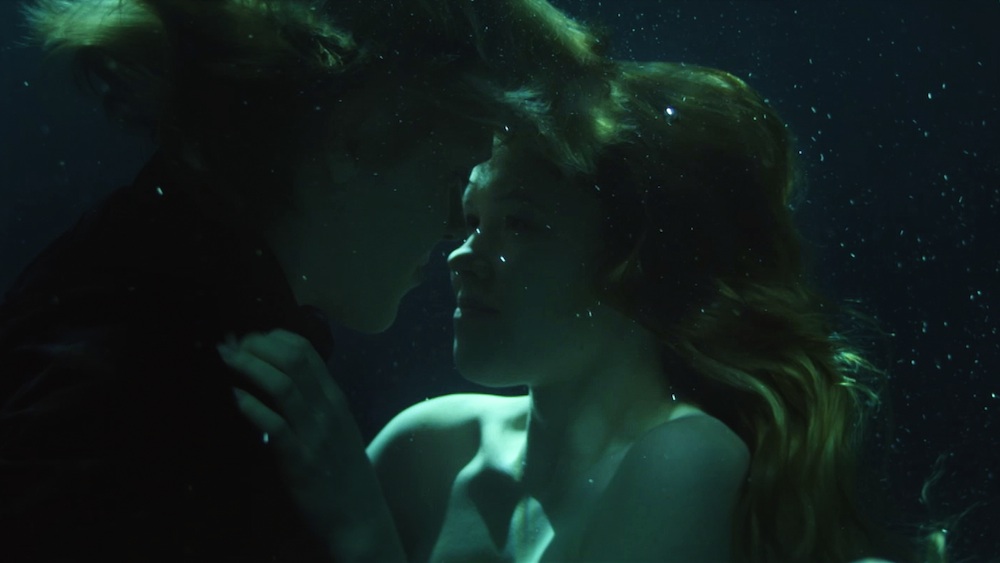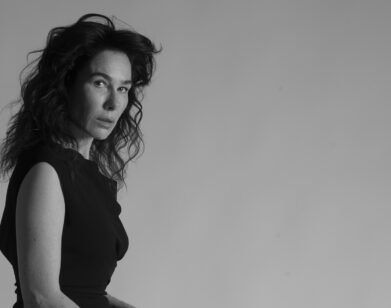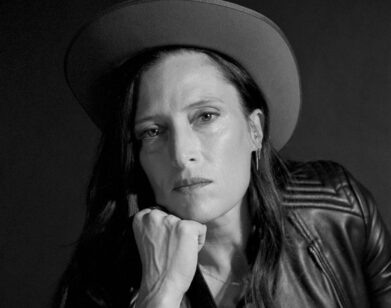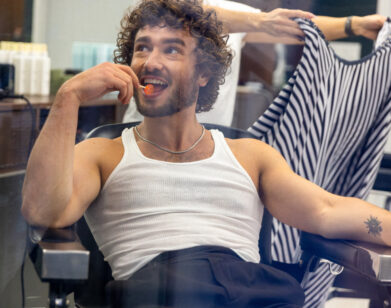Teenage Dream

ABOVE: MARTA MAZUREK AS SILVER AND JAKUB GIERSZAL AS MIETEK IN THE LURE. PHOTO COURTESY OF JANUS FILMS.
“To me, you’ll always be a fish,” a boy tells a teenage mermaid, gently rejecting her romantic advances. It’s a bruising, funny, and relatable moment in 38-year-old Polish director Agnieszka SmoczyÅ?ska’s inspired feature-film debut The Lure. SmoczyÅ?ska uses the genres of fantasy and horror to tell a coming-of-age story about two adolescent mermaid sisters who come ashore and become singers in an European underground nightclub restaurant (their act is called The Lure) during the ’80s. It turns out that mermaids—creatures that are “half-children, half-animals” in SmoczyÅ?ska’s words—serve as a perfect metaphor for developing girls grappling with their sexuality, objectification, and feelings of otherness. SmoczyÅ?ska’s mermaids have beautiful faces and cascading hair, but they also have beastly, slimy, long, eel-like fishtails. Last year at the Sundance Film Festival The Lure won a Special Jury Prize in the Dramatic World Cinema competition for “unique vision and design.” It’s a lush, arresting art film with the transporting surrealism of Björk’s music videos (which the filmmaker has named as an influence), the vivid colors and exhilarating energy of ’90s foreign hit Run Lola Run, and shades of the poetic Czech cult classic Valerie and Her Week of Wonders and the deranged Isabelle Adjani film Possession thrown in for good measure. It’s also a musical that was largely shot in an abandoned club in Warsaw and a vampire movie, in which the mermaids hunger for human flesh and—in a nod to Homer’s sirens—hypnotize people with their voices.
The dark-haired, rebellious Golden (Michalina OlszaÅ?ska) squints and smirks challengingly at adults, making it clear than she won’t be beholden to anyone, as she maneuvers through the nightlife world with its ramshackle glamour and a desolate, drab cityscape. Her sweet-tempered, ginger-haired sister, Silver (Marta Mazurek), is at once more mature than Golden and more vulnerable in her longing for earthly love. (Like her model, the eponymous character in Hans Christian Andersen’s “The Little Mermaid,” Silver seems willing to give up her voice for legs, so she can become a human being).
SmoczyÅ?ska is currently in Poland shooting The Fugue, her follow-up film about a woman with amnesia who doesn’t want to recover her memory. We recently spoke to the gracious and down-to-earth director by Skype as she was traveling to the set.
JULIA YEPES: Even though The Lure is fantastical, you did a lot of things to make it feel emotionally true to being a teenager. For example, the songs were interlaced into the story in such a way that it didn’t even feel like a musical. The songs just seemed like natural expressions of joy or angst or sadness.
AGNIESZKA SMOCZYÅ?SKA: Yes. I don’t know if you read this, but the band Ballady i Romanse, the WroÅ?ska sisters, they play such music. It’s anti-musical music, as you said. Zuzia’s lyrics are like poems, and Basia, her sister, composes the music. I had to visualize their songs; it was my goal, my task to do this. We were working together for, I don’t know, one year with our scriptwriter. One of the songs in the movie, Gold’s song to Silver when there is the fishtail operation—it was the same in real life because one of the WroÅ?ska sisters was in a hospital and the second sister, Basia, wrote this song to cheer her up.
I really like the song with the end credits because the lyrics are about this creature who is singing that she prefers to be under the water, on the car parts and the trash. “And this is much warmer than your arms!” This is the sense of the song. In Poland, they found a body of a 2-year-old boy in a river, and Basia wrote this song because she was so touched by this story. This is what you can feel. The lyrics are from the perspective of the boy. I think this is a beautiful song of the mermaid to the human being.
YEPES: What movies influenced you when you were a teenager?
SMOCZYÅ?SKA: When I was a teenager it was movies by Jim Jarmusch, because when I was in secondary school, I was in a film class where I was able to watch very good films from age 14 to 19. So we had history of cinema, and every week we went to the cinema. I remember the movies of Tarantino, of course, and Jarmusch, but Bergman was also an influence on me, and also Back to the Future [1985]. The Karate Kid [1984] was very important for me. But the main characters in most movies were boys or men, and I really liked movies where the main character is a woman or a girl. Which other movies when I was a teenager? When I was a child it was La Strada [1954] by Fellini. I liked Cronenberg’s Naked Lunch [1991]. But also I remember Arizona Dream [1993]. Of course, Batman [1989]. And Polish movies, especially Polanski and KieÅ?lowski. It was these directors that I really liked the most.
YEPES: What about Å»uÅ?awski?
SMOCZYÅ?SKA: Andrzej Å»uÅ?awski, of course, and Agnieszka Holland, of course. And Andrzej Wajda. We had great, great filmmakers during communism. I grew up on these movies. To be honest, I didn’t like horror, I didn’t like thrillers. So this is my first movie, but my previous thoughts—they were normal psychological drama.
YEPES: [laughs] No wonder you like Bergman.
SMOCZYÅ?SKA: Yeah, exactly. Antonioni, Bergman. Very serious art cinema.
YEPES: I saw a connection between your movie and Å»uÅ?awski because his movie Possession [1981] deals with extreme emotions. The main character is dealing with the fallout of an ending relationship, so it deals with extreme grief, extreme despair.
SMOCZYÅ?SKA: Yes.
YEPES: And this movie also deals wild emotions and expresses them in unusual ways. Silver and Golden are topless for a lot of the movie. Why did you think you think that was necessary?
SMOCZYÅ?SKA: We were thinking about it very seriously. If you can see mermaids in paintings and in the sculptures in Warsaw and also in Denmark, they don’t wear bras. Bras were put on via Disney, not artists. Because Disney was for kids, that’s why they had to add the bra. A mermaid doesn’t need to wear a bra because she doesn’t feel that she’s naked. And we wanted to tell about creatures that do not feel ashamed because they are not human beings. For us, it was very important that our mermaids don’t wear bras.
YEPES: Did you feel that might limit who sees the movie?
SMOCZYÅ?SKA: We didn’t want to tell the story to the kids. It’s a fairytale for adults. In Poland, you can watch it after 16 years old. It was also important for us to not show nudity in an erotic way or porno way, just natural.
YEPES: The sisters have a telepathic connection to each other the way a lot of young girls that are good friends do. And in the movie, it’s signaled by a dolphin-like sound. How did you work with the sound designer to arrive at that noise and in general?
SMOCZYÅ?SKA: The sound design was crucial. I started to work with the sound designer after the first draft of the treatment. I treated the whole script as a score. I knew the sound design would involve the horror genre, the horror convention of the film, and also I was working with the sound designer on how to create the language of mermaids. We thought maybe they should speak via words. Then we started reading about fish, and fish can sometimes communicate via telepathy. So that’s when we decided to use it. But you can hear dolphins, sharks, many underwater sounds—I think there are like 19 levels of sound in our telepathy.
YEPES: How did you connect with the artist whose work is in the animated opening sequence?
SMOCZYÅ?SKA: For the opening sequence, I used paintings from Aleksandra Waliszewska, a Polish painter. She invented the creepy, long, wet fishtail. I like this image because the mermaid is like a beautiful, sad monster.
YEPES: But how did you meet her? Or how did you know her work?
SMOCZYÅ?SKA: [Scriptwriter] Robert [Bolesto] and I knew her paintings from the internet. At the opening of her exposition, I came to her and said, “I’m a filmmaker, and I would love to work with you. I would like to make a movie about mermaids—could you paint the mermaid?” And she said, “No, I have to feel it.” Then we sent her a treatment. After maybe a week or two weeks, she started to send us some paintings and they were fantastic. It was a huge inspiration for our team.
YEPES: How did you cast the lead actresses?
SMOCZYÅ?SKA: In the beginning, I thought because the characters were in their teens, maybe teenagers should act it, but after a while, I realized it’s not possible for a teenager to act such a very, very hard role. We had a casting and we saw about 2,000 girls. [What we were looking for] was hard to find. But first of all we found Marta Mazurek, Silver. Then I started to look for her sister because I really needed the chemistry between them.
YEPES: Your cinematographer used special old lenses and lamps to help create the bright colors and the mood for the movie.
SMOCZYÅ?SKA: Yes. [Jakub] Kijowski joined us maybe two weeks or two months before the shoot. So it was very, very late, but he was fantastic. His input was really huge, because I gave him the music, I gave him the script, and he started to think about the whole visualization.
YEPES: Were the saturated colors your idea?
SMOCZYÅ?SKA: I showed him images of Diane Arbus, Nan Goldin, and also Waliszewska, and I told him, “I want something like this.” I showed one particular picture of Waliszewska’s, and when he watched the movie after editing, he told me he realized the film is very similar. Because he’s also really young, we really used our imagination, not our experience.
YEPES: I read that you made a short film about a woman who was transfixed by her neighbor’s voice, and also a documentary about an opera singer who was getting older and losing her voice. So I thought it was interesting that that theme continues in this movie.
SMOCZYÅ?SKA: Yes, yes, this is true. But this was very subconscious. I didn’t think about it. Maybe I’m interested in the beauty of the voice, the beauty of singing. The documentary was about Maria FoÅ?tyn, an opera singer, a diva. My short film was about an opera singer who seduced her neighbor via her voice. Our mermaids seduce people also via their voices. And I like this, because voice is something you can’t paint, you can’t photograph it, but you can show it in a movie.
YEPES: You evoke the heady feeling of being on the verge of womanhood so well in The Lure. Would you ever be interested in making a full-length movie about adults? Because the adults in the movie don’t seem happy. I know we’re kind of seeing things from the point of view of the sirens, but the lives of the grown-ups are pretty bleak. I was wondering what your views of adulthood are. Is it possible to be happy as an adult?
SMOCZYÅ?SKA: [laughs] I don’t know. It’s a hard question. It depends if you cut your fishtail or not. I think what I like in this movie, in this story, in this archetype is when you’re growing up, before you become a woman, and when you are not a child, in this state, when you are a mermaid metaphorically, you can build yourself or you can lose yourself.
THE LURE IS CURRENTLY PLAYING AT IFC CENTER IN NEW YORK CITY.






